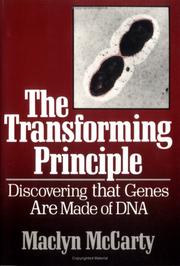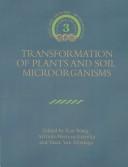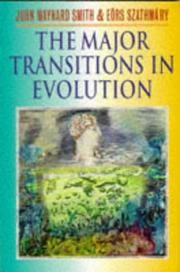| Listing 1 - 10 of 156 | << page >> |
Sort by
|

ISBN: 0393304507 9780393304503 Year: 1986 Publisher: New York: Norton,
Abstract | Keywords | Export | Availability | Bookmark
 Loading...
Loading...Choose an application
- Reference Manager
- EndNote
- RefWorks (Direct export to RefWorks)
Book
ISBN: 9780393019513 0393019519 Year: 1985 Publisher: New York (N.Y.): Norton,
Abstract | Keywords | Export | Availability | Bookmark
 Loading...
Loading...Choose an application
- Reference Manager
- EndNote
- RefWorks (Direct export to RefWorks)
Book
ISBN: 1349118915 Year: 1990 Publisher: New York : Stockton Press,
Abstract | Keywords | Export | Availability | Bookmark
 Loading...
Loading...Choose an application
- Reference Manager
- EndNote
- RefWorks (Direct export to RefWorks)
A practical manual of protocols for achieving expression of foreign genes in mammalian cells. It includes some very new techniques such as PCR-based expression. The author gives a theoretical introduction to the protocols and compares the strengths and weaknesses.

ISBN: 0521450896 Year: 1995 Publisher: Cambridge ; New York (N.Y.) : Cambridge university press,
Abstract | Keywords | Export | Availability | Bookmark
 Loading...
Loading...Choose an application
- Reference Manager
- EndNote
- RefWorks (Direct export to RefWorks)
Over the past fifty years plant breeders have achieved impressive improvements in yield, quality and disease resistance. These gains suggest that many more modifications might be introduced if appropriate genes can be identified. Current DNA techniques allow the construction of transgenic plants and this important new book reviews the current state of knowledge. A team of leading researchers provide in-depth reviews at the cutting edge of technology for laboratory techniques for the transformation of important soil microorganisms and recalcitrant plants of economic value. The book is divided into three sections: soil microorganisms; cereal crops; and industrially important plants. The most effective methods used to date are compared, and their merits and limitations discussed. Some chapters emphasise case studies and applications. In cases where obstacles remain to be overcome, an overview of progress to date is given. The book will serve as a general guide and reference tool for those working on transformation in microbiology and plant science.
Crops --- Genetic transformation. --- Plant genetic transformation. --- Soil microbiology. --- Genetic engineering.
Book
ISBN: 0511752261 Year: 1995 Publisher: Cambridge : Cambridge University Press,
Abstract | Keywords | Export | Availability | Bookmark
 Loading...
Loading...Choose an application
- Reference Manager
- EndNote
- RefWorks (Direct export to RefWorks)
Over the past fifty years plant breeders have achieved impressive improvements in yield, quality and disease resistance. These gains suggest that many more modifications might be introduced if appropriate genes can be identified. Current DNA techniques allow the construction of transgenic plants and this important new book reviews the current state of knowledge. A team of leading researchers provide in-depth reviews at the cutting edge of technology for laboratory techniques for the transformation of important soil microorganisms and recalcitrant plants of economic value. The book is divided into three sections: soil microorganisms; cereal crops; and industrially important plants. The most effective methods used to date are compared, and their merits and limitations discussed. Some chapters emphasise case studies and applications. In cases where obstacles remain to be overcome, an overview of progress to date is given. The book will serve as a general guide and reference tool for those working on transformation in microbiology and plant science.
Plant genetic transformation. --- Crops --- Genetic transformation. --- Soil microbiology. --- Genetic engineering.
Book
ISBN: 0195090152 Year: 1994 Publisher: New York (N.Y.) : Oxford university press,
Abstract | Keywords | Export | Availability | Bookmark
 Loading...
Loading...Choose an application
- Reference Manager
- EndNote
- RefWorks (Direct export to RefWorks)
Genetic engineering --- Genetic transformation. --- Transgenic organisms. --- Methodology.

ISBN: 0191919233 0191586005 9780191586002 019850294X 9780198502944 9780191919237 Year: 1997 Publisher: Oxford New York Oxford University Press
Abstract | Keywords | Export | Availability | Bookmark
 Loading...
Loading...Choose an application
- Reference Manager
- EndNote
- RefWorks (Direct export to RefWorks)
During evolution, there have been several major changes in the way that genetic information is organised and transmitted from one generation to the next. These transitions include the origin of life itself, the first eukaryotic cells, reproduction by sexual means, the appearance of multicellular plants and animals, the emergence of cooperation and of animal societies, and the unique language ability of humans. In discussing such a wide range of topics in one volume, the authors are able to highlight the similarities between different transitions - for example, between the union of replicating molecules to form chromosomes and of cells to form multicellular organisms.
Evolution (Biology) --- Genetic transformation. --- Natural selection.
Book
ISBN: 0008310718 9780008310714 Year: 2019 Publisher: [Place of publication not identified] WILLIAM COLLINS
Abstract | Keywords | Export | Availability | Bookmark
 Loading...
Loading...Choose an application
- Reference Manager
- EndNote
- RefWorks (Direct export to RefWorks)
Our understanding of the ‘tree of life’, with powerful implications for human genetics, human health and our own human nature, has recently completely changed. This book is about a new method of telling the story of life on earth – through molecular phylogenetics. It involves a fairly simple method – the reading of the deep history of life by looking at the variation in protein molecules found in living organisms. For instance, we now know that roughly eight per cent of the human genome arrived not through traditional inheritance from directly ancestral forms, but sideways by viral infection. In The Tangled Tree, acclaimed science writer David Quammen chronicles these discoveries through the lives of the researchers who made them – such as Carl Woese, the most important little-known biologist of the twentieth century; Lynn Margulis, the notorious maverick whose wild ideas about ‘mosaic’ creatures proved to be true; and Tsutomu Wantanabe, who discovered that the scourge of antibiotic-resistant bacteria is a direct result of horizontal gene transfer, bringing the deep study of genome histories to bear on a global crisis in public health. Quammen explains how molecular studies of evolution have brought startling recognitions about the tangled tree of life – including where we humans fit into it. Thanks to new technologies, we now have the ability to alter even our genetic composition – through sideways insertions, as nature has long been doing. The Tangled Tree is a brilliant exploration of our transformed understanding of evolution and of life’s history itself.
Evolutionary genetics --- Genetic transformation --- Evolution (Biology)
Book
ISBN: 9783867270687 3867270686 Year: 2006 Publisher: Göttingen : Cuvillier,
Abstract | Keywords | Export | Availability | Bookmark
 Loading...
Loading...Choose an application
- Reference Manager
- EndNote
- RefWorks (Direct export to RefWorks)
Plant genetic engineering. --- Plant genetic transformation.
Dissertation
Year: 1998
Abstract | Keywords | Export | Availability | Bookmark
 Loading...
Loading...Choose an application
- Reference Manager
- EndNote
- RefWorks (Direct export to RefWorks)
proteins --- protein synthesis --- genetic transformation --- Gene synthetique
| Listing 1 - 10 of 156 | << page >> |
Sort by
|

 Search
Search Feedback
Feedback About UniCat
About UniCat  Help
Help News
News